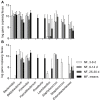New insights in gut microbiota establishment in healthy breast fed neonates
- PMID: 22957008
- PMCID: PMC3431319
- DOI: 10.1371/journal.pone.0044595
New insights in gut microbiota establishment in healthy breast fed neonates
Abstract
The establishment of a pioneer gut microbiota is increasingly recognized as a crucial stage in neonatal development influencing health throughout life. While current knowledge is mainly based on either culture or molecular analysis of feces, we opted for a comprehensive approach complementing culture with state-of-the-art molecular methods. The bacterial composition in feces from seven healthy vaginally-delivered, breast-fed neonates was analyzed at days 4-6, 9-14 and 25-30 postnatal, using culture, 16S rRNA gene sequencing of isolates, quantitative PCR and pyrosequencing. Anaerobes outnumbered facultative anaerobes in all seven neonates within the first days of life, owing to high levels of Bifidobacterium and unexpectedly also Bacteroides, which were inversely correlated. Four neonates harbored maternal Bacteroides levels, comprising typical adult species, throughout the neonatal period, while in three only subdominant levels were detected. In contrast, the major adult-type butyrate-producing anaerobic populations, Roseburia and Faecalibacterium, remained undetectable during the neonatal period. The presence of Bacteroidetes as pioneer bacteria in the majority of neonates studied demonstrates that adult-type strict anaerobes may reach adult-like population densities within the first week of life. Consequently the switch from facultative to strict anaerobes may occur earlier than previously assumed in breast-fed neonates, and the establishment of the major butyrate-producing populations may be limited by other factors than the absence of anaerobic conditions. The impact of breast milk components on the timing of establishment of anaerobic pioneer bacteria, as well as opportunistic pathogens should be further studied in regard to priming of the gut-associated immune system and consequences on later health.
Conflict of interest statement
Figures




References
-
- Backhed F, Ley RE, Sonnenburg JL, Peterson DA, Gordon JI (2005) Host-bacterial mutualism in the human intestine. Science 307: 1915–1920. - PubMed
-
- Guarner F, Malagelada JR (2003) Gut flora in health and disease. Lancet 361: 512–519. - PubMed
-
- Kelly D, King T, Aminov R (2007) Importance of microbial colonization of the gut in early life to the development of immunity. Mutat Res 622: 58–69. - PubMed
Publication types
MeSH terms
Substances
LinkOut - more resources
Full Text Sources
Other Literature Sources
Medical

